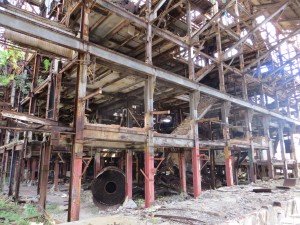 This is the last of my three posts on how to benefit at the cost of your successor. And again, please don’t. This is more of a warning on how to damage the plant for the benefit of the manager. And again, I hope rather than someone using this as a to-do list, someone uses it to see dangers. This last post looks at the worst “trick” of them all, burning the goodwill of your employees for a quick buck. It also looks at the one easiest to see, selling the plant and renting it back.
This is the last of my three posts on how to benefit at the cost of your successor. And again, please don’t. This is more of a warning on how to damage the plant for the benefit of the manager. And again, I hope rather than someone using this as a to-do list, someone uses it to see dangers. This last post looks at the worst “trick” of them all, burning the goodwill of your employees for a quick buck. It also looks at the one easiest to see, selling the plant and renting it back.
Fails
How to Look Good at the Cost of Your Successor (Please Don’t!)–Part 2
 This is the second post in this short three-post series on how to look good while driving the plant into the ground. Again, the following is intended more of a warning on how NOT to do it, even though I fear some may use it as a checklist. My hope is that even more see the signs and can stop it, or at least not reward the person in question for this type of skullduggery. I will also talk briefly about how to recognize and counteract this type of behavior for the long-term health and success of your plant.
This is the second post in this short three-post series on how to look good while driving the plant into the ground. Again, the following is intended more of a warning on how NOT to do it, even though I fear some may use it as a checklist. My hope is that even more see the signs and can stop it, or at least not reward the person in question for this type of skullduggery. I will also talk briefly about how to recognize and counteract this type of behavior for the long-term health and success of your plant.
How to Look Good at the Cost of Your Successor (Please Don’t!)–Part 1
 This post series will be an unusual one. I will tell you how to look good in manufacturing at the cost of your successor. Of course, I do NOT want you to do that. Not only will there be no improvement, but instead the plant will be worse in the long run at the cost of a short-term benefit. This is a somewhat sarcastic post on the dirty tricks you can use to look good, while at the same time driving your (future) plant into the ground. The responsible managers of course will be somewhere else before the inevitable happens. Even though the approaches below are bad for the plant, I am sure some managers will use this as a checklist. But I hope that even more people will see it as a list of warnings for bad managers.
This post series will be an unusual one. I will tell you how to look good in manufacturing at the cost of your successor. Of course, I do NOT want you to do that. Not only will there be no improvement, but instead the plant will be worse in the long run at the cost of a short-term benefit. This is a somewhat sarcastic post on the dirty tricks you can use to look good, while at the same time driving your (future) plant into the ground. The responsible managers of course will be somewhere else before the inevitable happens. Even though the approaches below are bad for the plant, I am sure some managers will use this as a checklist. But I hope that even more people will see it as a list of warnings for bad managers.
Volkswagen Supplier Relations Failure
 In the last months, there has been an unprecedented power struggle between Volkswagen and its suppliers. Two of the suppliers stopped delivering, leading to a full stop of multiple production lines at six Volkswagen plants, including its main plant Wolfsburg. This whole mess comes on top of the separate problems Volkswagen has had with its Dieselgate. In this post I would like to look in more detail at what happened.
In the last months, there has been an unprecedented power struggle between Volkswagen and its suppliers. Two of the suppliers stopped delivering, leading to a full stop of multiple production lines at six Volkswagen plants, including its main plant Wolfsburg. This whole mess comes on top of the separate problems Volkswagen has had with its Dieselgate. In this post I would like to look in more detail at what happened.
More On Cuba’s Planned Economy: Cuban Industry

A few weeks ago I wrote an article on the Cuban economy, focusing on commerce (See How a Planned Economy Can Screw Up an Entire Country – Analogy between Cuba’s Communist Economy and Push Systems). On the same visit I not only saw supermarkets, but I also had a look at industry. Unfortunately there are no visitors allowed in their government factories. Nevertheless, I was able to catch some glimpses of different industries.
Lies, Damned Lies, and KPI – Part 2: Effects of Fudging

Modern manufacturing works with a lot of performance measures, often called key performance indicators (KPIs). Unfortunately, they are rarely accurate, and often even intentionally misleading. In my previous post I described some examples of commonly manipulated KPIs. In this post I would like to explain the ugly consequences of incorrect or manipulated KPIs. In a final post I will also show some ways that you can reduce this negative effect. But first, how do bad KPIs (and hence most KPIs) hurt your company?
Lies, Damned Lies, and KPI – Part 1: Examples of Fudging

Statistical measurements, usually called key performance indicators (KPIs) are found on pretty much every shop floor and in every company. Many management decisions are made based on KPI. Unfortunately, these numbers often are not reliable at all.
Mark Twain popularized the phrase “Lies, damned lies, and statistics.” Winston Churchill famously said, “I only believe in statistics that I doctored myself.” Hence, both men were wary of trusting numbers. You should be too!
How a Planned Economy Can Screw Up an Entire Country – Analogy between Cuba’s Communist Economy and Push Systems
 Over Christmas I escaped the cold weather in Germany and relaxed on the warm beaches in Cuba. Of course, being a lean expert, I was also interested in the Cuban economy. As a communist economy (or more precisely, a socialist economy), it is based on centralized planning. In comparison, the capitalist system of the US (and most of the rest of the world) leaves most business decisions to individual entrepreneurs. This is somewhat similar to push and pull in manufacturing. Push systems also rely on centralized planning, while pull systems have their signal from inside the system to match the customer demand. As capitalism outperforms communism, pull usually outperforms push. Hence, in this post I would like to show you the shenanigans that happen in Cuba due to the effects of centralized planning. Warning: Lots of images ahead!
Over Christmas I escaped the cold weather in Germany and relaxed on the warm beaches in Cuba. Of course, being a lean expert, I was also interested in the Cuban economy. As a communist economy (or more precisely, a socialist economy), it is based on centralized planning. In comparison, the capitalist system of the US (and most of the rest of the world) leaves most business decisions to individual entrepreneurs. This is somewhat similar to push and pull in manufacturing. Push systems also rely on centralized planning, while pull systems have their signal from inside the system to match the customer demand. As capitalism outperforms communism, pull usually outperforms push. Hence, in this post I would like to show you the shenanigans that happen in Cuba due to the effects of centralized planning. Warning: Lots of images ahead!
